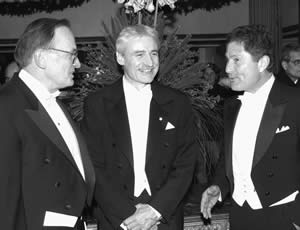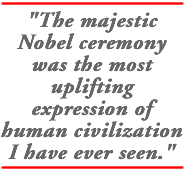From the President
A Noble Amibition
Officially, we democratic Americans take a dim view of royalty, aristocracy, and pomp and circumstance. But in fact (to the amusement of social commentators on both sides of the Atlantic), we tend to show a pronounced weakness for these things in the flesh. After four days in Stockholm for the Nobel Prize ceremony, I understand why.
Quite simply, the majestic Nobel ceremony was the most uplifting expression of human civilization I have ever seen.

President Richard L. McCormick, right, congratulates UW Genome Sciences Professor Lee Hartwell, center, at a banquet for winners of the Nobel Prize in Stockholm, Sweden. At the left is Shan Mullin, chair of the Fred Hutchinson Cancer Research Center Board of Trustees. Hartwell is also president and director of the cancer center. Photo by Ecke Kuller.
My ticket to Stockholm was the brilliant geneticist Leland Hartwell, who last October became the fifth University of Washington faculty member to win a Nobel Prize. (Hartwell currently heads the Fred Hutchinson Cancer Research Center, but he remains a UW professor, and the work for which he earned the Nobel was primarily done here.) The day before the prize ceremony itself, he delivered his Nobel lecture, a crystal-clear account of his decades of research using yeast to tease out the genetic mechanisms of cell division (see "Hartwell Wins Nobel Prize in Medicine," Dec. 2001). From the lecture, characteristically modest and generous, one would scarcely think Lee had done any of the work himself. The Nobel committee obviously knew better.
On Monday, Dec. 10, the anniversary of Alfred Nobel's death, we gathered for the award ceremony in Stockholm's beautiful Concert Hall. The audience of 1,800 or so was seated early-all dressed, like the participants, in white tie and tails or long gowns. I had a perfect seat near the center of a balcony.
For this special centennial of the Nobel awards, all living laureates had been invited to attend. About two hundred of them did (including the UW's Edmond Fischer and Edwin Krebs), and they were the first to take their seats (gilded, not folding) on the stage. It was a remarkable sight-a solid phalanx of genius, dressed to the nines. Then the Royal Stockholm Philharmonic played a royal anthem to bring on the King of Sweden and his family. They looked the part. Finally the 2001 laureates appeared, proceeding to their front-row seats as the orchestra played a Mozart march.
 The ceremony that followed was a formal ritual, flawlessly choreographed. For the awards in each field, first came a spoken tribute (in Swedish, but we had English translations) to the work being honored. Then we all rose as each laureate walked to meet the king at the center of the stage, received his diploma and a handshake to the accompaniment of a trumpet fanfare, and then stepped back and bowed, first to the king and then to his fellow laureates. Between awards, the orchestra and soprano Anne Sofie von Otter performed Handel, Stravinsky and Mahler.
I found the ceremony riveting. Was it just the undeniable glamour? I don't think so. At the center of everything was human intellectual achievement, and the ceremony was powerful precisely because it expressed so well the nobility of that achievement. Words, music, ritual, the presiding image of royalty, all placed the laureates' work in a context of the highest human aspirations.
The other all-pervasive context, no doubt partly because of the centennial, was history. As a historian, I was especially moved by repeated references to the earlier achievements on which the current Nobel winners had built. The citation for Lee Hartwell, for example, related his work to the seminal discovery, almost 50 years earlier, of the double helix-and of course Nobel laureate James Watson, one of those who made that discovery, was himself sitting on the stage. In the end, one saw all these achievements, however brilliant in themselves, as part of one long, inspiring human endeavor.
"The Nobel Prizes and the Nobel Laureates," said the opening speaker, "have become symbols of a noble ambition to improve the circumstances of our earthly life." The ceremony itself, with all its regal elegance, was an unforgettable tribute to that noble ambition. Being there was a great privilege-almost as great a privilege as sharing a university with the likes of Leland Hartwell, Edmond Fischer, Edwin Krebs, E. Donnall Thomas and Hans Dehmelt.

Richard L. McCormick, President
|
 THE UNIVERSITY OF WASHINGTON ALUMNI MAGAZINE
THE UNIVERSITY OF WASHINGTON ALUMNI MAGAZINE
 THE UNIVERSITY OF WASHINGTON ALUMNI MAGAZINE
THE UNIVERSITY OF WASHINGTON ALUMNI MAGAZINE
